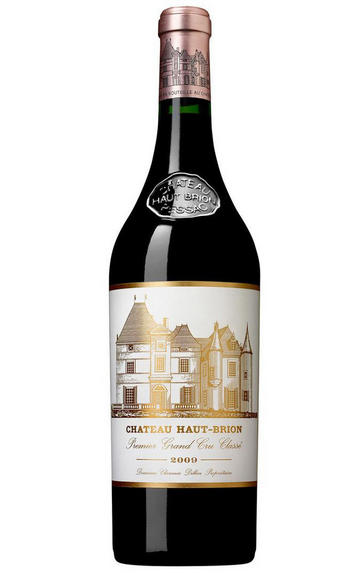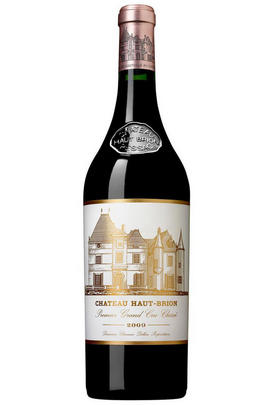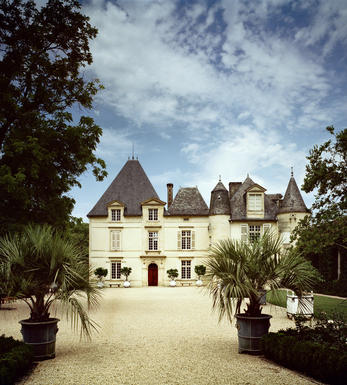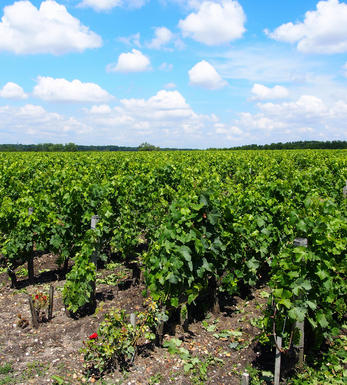
2001 Château Haut-Brion, Pessac-Léognan, Bordeaux

Critics reviews
You cannot really go wrong with the 2001 Haut-Brion, which showed similar to the one tasted just a few weeks earlier. The bouquet positively gushes with black cherries and violets, incense and here, a little more black olive. The palate is medium-bodied with firm tannins and sweet ripe black fruit laced with graphite, blood orange and hints of Provençal herbs on the substantial finish. It is drinking now but will give pleasure for 20-30 years more.
This was a suitable epic dinner. It was pleasing to see Tristan recovering from the pandemic and firing on all cylinders. God knows what fellow diners thought about the performance at the corner table. But hopefully, they could see that we were enjoying ourselves, something that had been denied so many of us in previous months.
Drink 2022 - 2048
Neal Martin, Vinous.com (June 2022)
A high yield of 52hl/ha, with 50% of the crop going to the grand vin. 75% new oak.
As with the 2000, this is still extremely young, barely out of the starting gates, and it needs time to open in the glass. It inches forward, rewarding patience with one of the most aromatically complex wines that you'll find in Bordeaux. Deep in colour, it has a great aromatic balance of spice, swirled cinnamon and liquorice. Mouthwateringly good.
Drink 2018 - 2038
Jane Anson, Decanter.com (September 2018)
Slightly darker colour. Thicker, denser and sweeter than the La Mission on the nose but much tighter and more tannic on the palate. Chewy and clearly set for great things.
Drink 2015 - 2035
Jancis Robinson MW, JancisRobinson.com (March 2012)
Haut-Brions 2001, which was bottled late (the end of September, 2003), possesses an unmistakable nobility as well as a burgeoning complexity. Plum/purple to the rim, this blend of 52% Merlot, 36% Cabernet Sauvignon, and 12% Cabernet Franc is playing it close to the vest, having closed down considerably after bottling. Nevertheless, it reveals pure notes of sweet and sour cherries, black currants, licorice, smoke, and crushed stones. Medium-bodied with excellent purity, firm tannin, and an angular, structured finish, it requires 5-7 years of cellaring.
Robert M. Parker, Jr., Wine Advocate (June 2004)
This charming wine was unfortunately overshadowed by the epic vintage just prior, yet the dark ruby colour and complex, savoury nose show a wine of breed and class that has the substance to age. High-toned cherry and red plum fruit aromas have oak spice, earth and cedar accents. The texture is firm and fresh, with plenty of acidity and enough stuffing to linger pleasantly on the finish. There is a slight dominance of Merlot in the blend at 52%, and the wine is aged in 75% new casks before bottling in October 2003.
Drink 2023 - 2045
Charles Curtis MW, Decanter.com (July 2023)
Full red-ruby, less bright than La Mission. Brooding aromas of raspberry, nuts, menthol and game. Dense, rich, chewy and deep but a bit youthfully closed, showing less personality today than the 2001 La Mission. Larger but not longer. Finishes with building tannins and a minty nuance.
In the historic harvest of 2003, Haut-Brion began harvesting its white grapes on August 13. But in this very warm microclimate within the city of Bordeaux, even the merlot harvest began on August 25, and all the cabernet was in by September 15. While tannin levels and alcohols are high (about 13% for both Haut-Brion and La Mission), the pHs are hardly excessive; enologist Jean-Philippe Masclet noted that the vines did not really suffer from drought.
The 1990 Haut-Brion, he pointed out, was more cooked in comparison to the 2003. Interestingly, the estate was high on the quality of its merlot in 2003; due to some coulure and the very small size of the grapes, the merlot yield was just 36 hectoliters per hectare. The young Haut-Brion, with a relatively high 58% merlot, boasts a thickness that reminded me of the extraordinary '89.
Stephen Tanzer, Vinous.com (May 2004)
About this WINE

Chateau Haut-Brion
The only property from outside the Médoc to be included in the 1855 Classification, Haut-Brion’s viticultural history can be traced back further than its Médoc First Growth counterparts. Samuel Pepys even mentions it in his diaries. Situated in what is now Pessac-Léognan, the property finds itself now in the suburbs of the ever-encroaching city of Bordeaux.
After falling into a state of disrepair the estate was purchased in 1935 by Clarence Dillon, an American financier, since when it has enjoyed a steady and continual resurgence to a position of pre-eminence. Dillon’s great-grandson, Prince Robert of Luxembourg, now runs the estate, but a key influence in the reputation which Haut-Brion enjoys today is the Delmas family. George Delmas was manager and wine-maker until 1960, when his son Jean-Bernard took over. Jean- Bernard was a visionary figure, responsible for a number of important innovations, and on his retirement in 2003 his son Jean-Philippe took over as Directeur Générale.
The vineyard is planted to 40% Cabernet Sauvignon, 37% Merlot and 18% Cabernet Franc. A stunning white wine is also made, from a part of the vineyard which is 63% Semillon and 37% Sauvignon Blanc. Production is smaller than at the other First Growth Wines, totalling about 20,000 cases, shared between the Grand Vin and a second wine, formerly called Bahans-Haut-Brion but changed in 2007 to Clarence de Haut-Brion in recognition of Clarence Dillon. Production of Haut Brion Blanc is minute, less than 800 cases in most years.
Beginning with the 2009 vintage a new white wine was introduced in the place of Clarence: La Clarté de Haut-Brion, the offspring of Domaine Clarence Dillon's two prestigious white wines: Château Haut-Brion Blanc and Château La Mission Haut-Brion Blanc.
Fermentation of the red wines takes place in stainless steel vats, after which the wine will spend 22 months, sometimes more, in new oak barrels before being bottled unfiltered. For the white wine fermentation takes place in new oak barrels, after which the wine spends a further year to 15 months on its lees in barrel before bottling. The white wine is truly sensational, equivalent in class to a top-flight White Burgundy Grand Cru, but its scarcity means that it is rarely seen.
The red wine is no less extraordinary; at its best it displays text-book Graves characteristics of cigar-box, curranty fruit, earth, smoky spice and cassis. The high Merlot content, compared to the Médoc First Growths, gives it a voluptuous edge, but does not in any way detract from its ability to age.

Pessac-Leognan
In 1986 a new communal district was created within Graves, in Bordeaux, based on the districts of Pessac and Léognan, the first of which lies within the suburbs of the city. Essentially this came about through pressure from Pessac-Léognan vignerons, who wished to disassociate themselves from growers with predominately sandy soils further south in Graves.
Pessac-Léognan has the best soils of the region, very similar to those of the Médoc, although the depth of gravel is more variable, and contains all the classed growths of the region. Some of its great names, including Ch. Haut-Brion, even sit serenely and resolutely in Bordeaux's southern urban sprawl.
The climate is milder than to the north of the city and the harvest can occur up to two weeks earlier. This gives the best wines a heady, rich and almost savoury character, laced with notes of tobacco, spice and leather. Further south, the soil is sandier with more clay, and the wines are lighter, fruity and suitable for earlier drinking.
Recommended Châteaux: Ch. Haut-Brion, Ch. la Mission Haut-Brion, Ch. Pape Clément, Ch Haut-Bailly, Domaine de Chevalier, Ch. Larrivet-Haut-Brion, Ch. Carmes Haut-Brion, Ch. La Garde, Villa Bel-Air.

Cabernet Sauvignon Blend
Cabernet Sauvignon lends itself particularly well in blends with Merlot. This is actually the archetypal Bordeaux blend, though in different proportions in the sub-regions and sometimes topped up with Cabernet Franc, Malbec, and Petit Verdot.
In the Médoc and Graves the percentage of Cabernet Sauvignon in the blend can range from 95% (Mouton-Rothschild) to as low as 40%. It is particularly suited to the dry, warm, free- draining, gravel-rich soils and is responsible for the redolent cassis characteristics as well as the depth of colour, tannic structure and pronounced acidity of Médoc wines. However 100% Cabernet Sauvignon wines can be slightly hollow-tasting in the middle palate and Merlot with its generous, fleshy fruit flavours acts as a perfect foil by filling in this cavity.
In St-Emilion and Pomerol, the blends are Merlot dominated as Cabernet Sauvignon can struggle to ripen there - when it is included, it adds structure and body to the wine. Sassicaia is the most famous Bordeaux blend in Italy and has spawned many imitations, whereby the blend is now firmly established in the New World and particularly in California and Australia.


Buying options
Add to wishlist
Description
This charming wine was unfortunately overshadowed by the epic vintage just prior, yet the dark ruby colour and complex, savoury nose show a wine of breed and class that has the substance to age. High-toned cherry and red plum fruit aromas have oak spice, earth and cedar accents. The texture is firm and fresh, with plenty of acidity and enough stuffing to linger pleasantly on the finish. There is a slight dominance of Merlot in the blend at 52%, and the wine is aged in 75% new casks before bottling in October 2003.
Drink 2023 - 2045
Charles Curtis MW, Decanter.com (July 2023)
wine at a glance
Delivery and quality guarantee